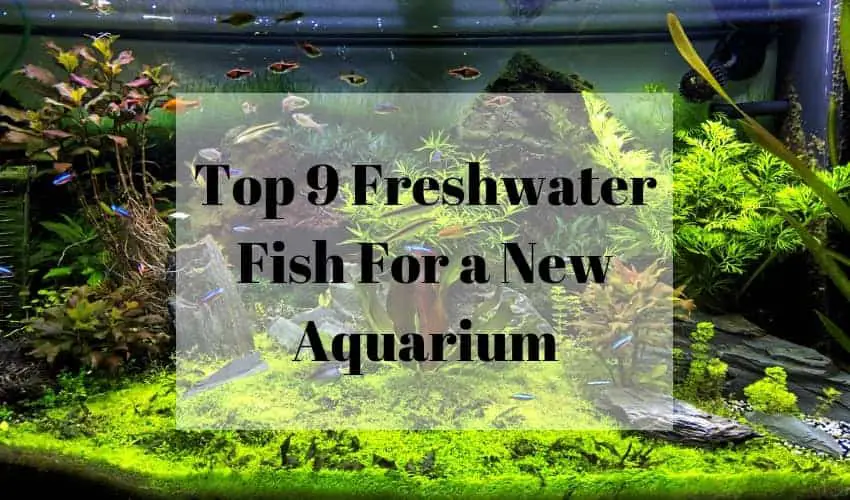Starting any new hobby can be daunting, especially if it involves livestock. Aquarium keepers all over the world had to start somewhere and most will start with a small freshwater tropical fish tank.
Beginners will often ask us for our advice on the Best freshwater tropical fish to start with and they often only know one or two types of fish. These are normally Neon Tetras, Betta, and Guppies, all perfectly good fish to start with. Easy to keep and easy to feed, but there are so many more alternatives you should consider.
Of course, these are included in the list below but we have also added some more unusual and interesting tropical freshwater fish to this list. All are readily available in your local store and won’t cost the earth.
Once your aquarium is established and you’re maintaining the water quality by carrying out regular water changes then you should consider adding other fish now that you have the hang of looking after these hardy species below. Fish like Angelfish, Dwarf Gourami, Clown Loach and Algae Eaters to name just a few.
These fish are more susceptible to poor water conditions, not that you should ever have them of course. They are also a little more tricky to feed and will only accept a certain type of foods.
So let’s have a look at the Top 9 Freshwater fish for a new aquarium
. PS. No 9 is our favorite!Table of Contents
Rasboras
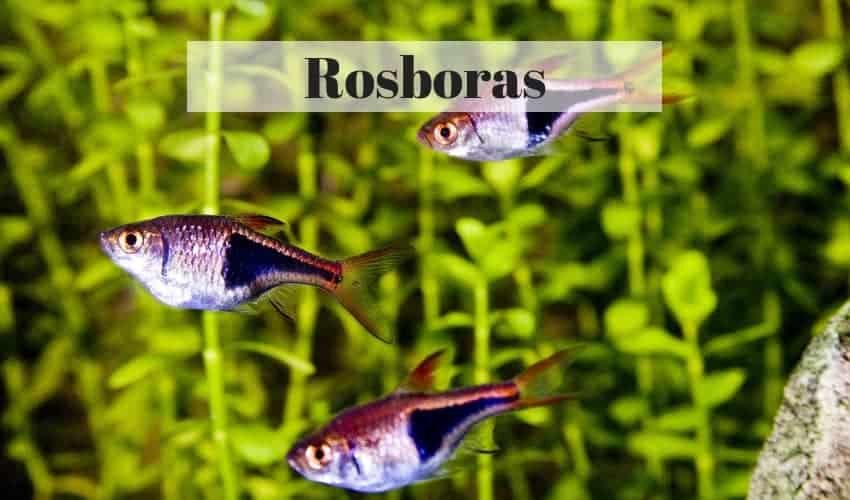
With dozens of species available in various colorations, sizes, and temperament, it should come as no surprise that the Rasbora is one of the most popular kept aquarium fish in the hobby. This is especially true of the beginner aquarium in which the Rasbora not only looks beautiful but also is a breeze to keep.
Though the aquarium requirements do vary between Rasbora species they do not differ by much and most species can be mixed, matched and kept together. You can create real bursts of color and life by doing just this, or keep it simple and create one species only dynamic displays. These generally small, but highly impactful fish can easily create an aquascape that really is to die for.
Aquarium requirements start at around 8-10 gallons tanks like the Fluval Flex9 for the smaller species around 2 inches, with the rarer, but larger approximately 4 inches, needing one that is around four foot in length. This is due to most of the Rasbora species being best kept in large shoals of around twelve specimens. The temperature in the Rasbora aquarium should be nearing 73 – 82℉ or 23 – 28℃.
The much loved Harlequin Rasbora is well and truly the favorite variety of this glorious fish and can be found in many aquariums both species only and mixed. They are orange to reddish copper in color with a black triangle reaching from the tip of their tail to mid-belly. They are incredibly peaceful and can reach up to 2 inches in length.
Another popular Rasbora choice is the giant of the species, the Clown Rasbora. These gargantuans can reach up to 4 inches in length, should be kept in shoals of twelve plus, and require the larger scale aquarium. They are also incredibly attractive with their orange tones and black marks that can be anywhere on their body. Despite their size Clown Rasbora are skittish and require a tight-fitting lid on their aquarium.
Last, but certainly not least, the Mosquito Rasbora has to have a mention in this popular variety list. These are the real teeny tinies of the Rasbora family at just 0.7 inches or 15 millimeters. What they lack in size, however, they certainly make up for in color. The Mosquito Rasbora is bursting with vibrant coloration including a highly recognizable black and yellow midbody stripe. They are perhaps, due to their size, best kept in a species only aquarium.
Swordtail
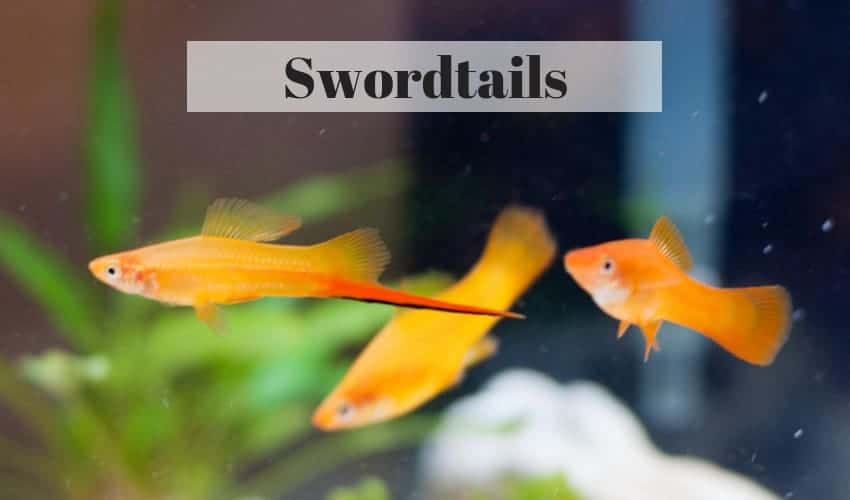
The swordtail is an old favorite in the aquarium hobby that definitely deserves its place on this list of freshwater fish for beginners. Not, however, as just an aquarium filler as many fish keepers tend to have them, but as an individual species that can hold its own!
Available nowadays in every color you can imagine and with a myriad of different fin types the Swordtail is a peaceful, yet active, and attractive addition to any aquarium set up. They are sociable, loving the company of other fish, and display interesting behavior between themselves. Suggested varieties to take a peek at would be; Lyretail, Koi, Tuxedo, Hi-fin, and Neon.
Behavior wise the Swordtail is an interesting species to watch. Females will flock around the males with the longest swords, they find them attractive, and the males will bicker amongst themselves. Posturing, the erecting of fins, circling each other, and mouth to mouth wrestling are all displays you can expect to see.
Interestingly, the sword which is an extension to the males caudal fin (tail) does not start to develop until they are approaching sexual maturity. This is probably because they do not need the sword until this time as it is used to attract mates and nothing more. Pardon the expression here, but the larger the appendage the more attractive the male is!
Keeping Swordtails is a doddle so long as you can cope with their prolific breeding, which the males will do as often as they can. For this very reason, males will harass the females, it is suggested you keep 3 – 4 females to every male. An aquarium of approximately 30 gallons would be needed for this at a temperature of 72 – 78℉ or 22 – 28℃. Swordtails love a good flow of water and will eat virtually anything you feed them.
Platies

The Platy is a commonly found inhabitant of many beginner aquariums due to its ease of care, sociable nature, and the plethora of varieties available. They are generally, on the small side not reaching over three inches in length, and can be kept in medium to large groups without bickering.
Being completely honest, the Platy is not the most exciting species to place in an aquarium from a behavioral point of view. They are active swimmers but also spend a fair amount of time hiding in amongst plants and decor. However, what they lack in the action stakes, they certainly make up for in their displays of color and patternation.
There are two main varieties of Platy, the Southern and Variatus, each of which contain multiple different species. These include but are not exclusive to; the Rainbow, the Hawaii, the Tuxedo, the Marigold, and the most popular Salt and pepper, Wagtail, and Variegated.
All three of the most popular platy types can be of any color including red, gold, yellow, orange, and silver. This, however, is where the similarities end. The Wagtail is distinguished by its black rays on its caudal and dorsal fins, the Variegated by the dark splotches of various sizes all over its body. Finally the Salt and Pepper, and my personal favorite, has a number of black spots rather than splotches.
Care wise the Platy is best kept in groups with two females to every male. This, like the Swordtail, is due to the male being a bit of a ‘sex pest’ towards the girls. Platies breed at a prolific rate approximately every thirty days with 20 – 80 fry being born every time. Luckily, or unluckily, depending on how you look at it Platies will eat their young meaning only a few will survive out every batch. Gentle filtration is preferred by platies and if you are breeding them you’ll need a small sponge filter so that their fry are not harmed. Read our review of the best filters for small fish tanks.
Guppy

The gorgeous Guppy holds a special place in my heart and the hearts of many aquarists who started off their fish keeping hobby with these delightful little guys. They really are the ultimate, though not the hardiest, beginner fish that you could wish to own. They are pretty, active, peaceful, and come in so many varieties you will not know which to pick!
Aesthetically the Guppy has an elongated body with long flowing fins and is around 5 centimeters or 2 inches in size. They come in multiple colors, patterns and fin types, in fact, there are over 35 different species recorded, meaning there is a type out there for everyone.
Whilst all species of Guppies have proved to be popular, some are more favored than others. These include the Fantail, also known as a fancy guppy which has a large fan-shaped tail and can come in many colors. The Snakeskin which has a vertical pattern all over its body, often resembling the stripes of a tiger in gold, orange, and black. And last but not least the Albino which is commonly all white with soft pink to reddish eyes.
Care wise Guppies need an aquarium of around 5 gallons per three specimens, two of which should be female. We personally like the Fluval Flex 57 which is a more spacious tank at 15 gallons, perfect for a small community tank.
They require temperatures of 64 – 82℉ or 18 – 28℃ and plenty of foliage and hiding spots. This is due to them being of a shy nature even amongst their own species. Guppies can be kept in community aquariums but are best species only as other fish have a tendency to nip at their elaborate and large tails.
Interestingly Guppies are an ovoviviparous breeding species meaning that the eggs form inside of the female without her providing any nourishment to the developing fry. Instead, the embryos feed on their yolk sacs until they are used up and they hatch inside the female. This means Guppy fry are born as fully formed youngsters.
Neons

With over 1.5 million being exported into the US every single month the Neon Tetra has to be the most popular aquarium fish, especially for beginners, of all time! Why? Well, undeniably, I believe, because they are just so amazing looking, especially when swimming in large schools.
Thought of by many as the aquarium jewel in the crown the Neon tetra is a small, 1.5-inch maximum, torpedo-like shaped fish with a silvery base color. Down their middle runs a neon blue stripe and a bright red one that is their most famous asset. This coloration is brilliant and dazzling only fading at night, when the fish or threatened, or they fall sick.
Care wise the Neon tetra requires an aquarium size of 10 gallons for a shoal of six. Six is the minimum number recommended to be kept together but if you can you should keep more. I say this because there really is nothing like a huge shoal of 20 plus Neon tetras swimming together rapidly around a large live planted aquarium. Their colors pop against the green background and I really can’t say enough how attractive a sight they are.
Fairly shy even when in a large school the Neon tetra requires low light and plenty of hiding places such as rocks and driftwood. The water temperature should be around 68 – 79℉ or 20 0 26℃. Food wise Neon tetras are omnivores and happy to eat most anything. Recommended foods would be flakes, granules, frozen brine shrimp, daphnia, and bloodworms.
We have a complete guide to neon tetra which you may find interesting and definitely worth a read.
Please note Neon tetras make good tank mates to non-aggressive similar sized fish and also, with care, larger slow moving fish that the nippy Neon tetra can avoid easily. Speaking of nippy, Neon tetras have a tendency to be so to fish that have long flowing fins or brighter colors than them. A touch of jealousy perhaps!
Danios
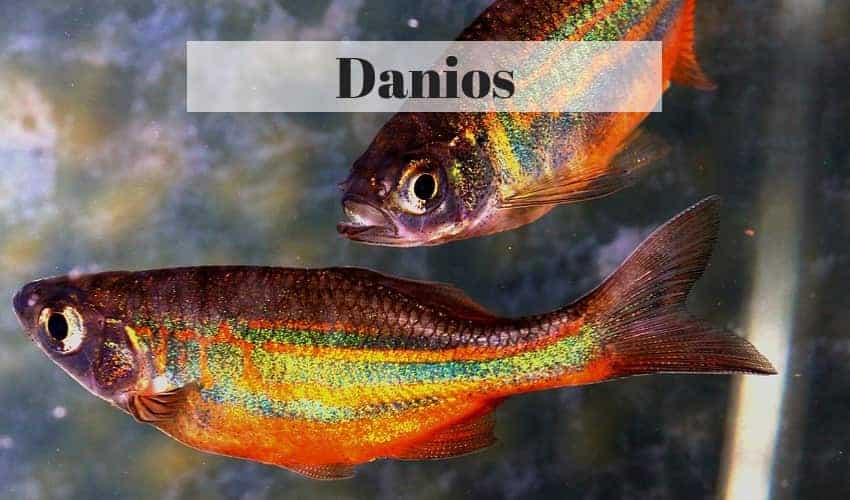
Danios are an underrated and under kept cold water species that are hardy, lively, and come in a range of attractive species. They are a schooling fish best kept in groups of six or more and like long aquariums with surface plants and hiding spots. Be aware that many species of Danio can be pretty boisterous which can be alarming. However, they are not aggressive so other species in your aquarium will be just fine.
The dwarf spotted danio can reach around two inches in length and requires an aquarium of 10 gallons plus. They are beige in coloration with a white stripe running down their bodies. Either side of the white stripe is a thin black line. Dwarf spotted danios prefer lots of live plants and dim lighting.
The giant danio is, as its name suggests, the largest of the danios at around four inches. They are an attractive blue with bright orange markings and need to be kept with larger fish than themselves. A minimum aquarium size of 30 gallons is recommended. We like the SeaClear Acrylic 30 Gallon aquarium available and delivered by Amazon straight to your door.
The pearl danio is probably the most attractive of all the danios. It is pearlescent with pretty orange fins and should be kept in schools of four or more. They reach around 2 inches in size and require an aquarium of 20 gallons.
The zebra danio is undoubtedly the most recognizable of the species with its black-and-white striped pattern. They are incredibly active, very sociable, and require an aquarium of 10 gallons for their maximum of 2-inch bodies.
The rosy danio is the smallest of the species at a teeny tiny 1.25 inches. They are a pinkish pearlescent color, relatively hardy and peaceful, and need an aquarium of at least 20 gallons. The rosy danios are a relative newcomer to the aquarium trade and proving to be incredibly popular.
Last but not least is the white cloud mountain minnow which is commonly referred to as the ‘poor man’s neon tetra.’ No doubt this is a jibe at its muted but similar coloration to that of the Neon, but it is rather unfair. The white cloud mountain minnow is rather stunning in its own right and well worth taking a look at. They are another tiny species at around 1.5 inch and require a 10-gallon aquarium.
Cory Catfish
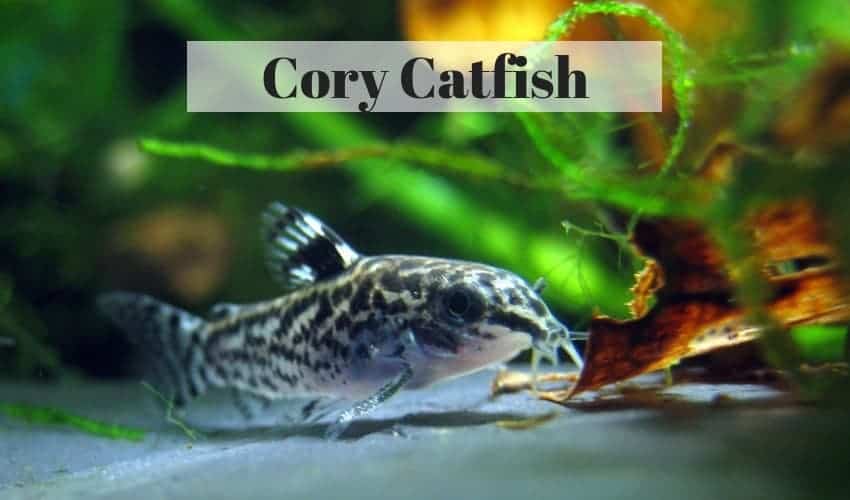
Also known as the Cory cat, Cory fish, and Corydora, the Cory catfish is a highly popular bottom feeder that has an armored set of bone-like material running down their bodies. Although they are definitely an ideal beginner aquarist species, they are also frequently kept by more experienced fish keepers.
Personality wise the Cory catfish is calm, peaceful, non-aggressive, and incredibly sociable with their own kind. They can, however, be shy and timid with other species and in the presence of their keepers. They are most active during the day when they will spend most of their time scavenging for food but have been known to also remain still for hours. Every so often you may see your Cory catfish make a break for the surface, gulp air, and then swim back down. This is nothing to be alarmed by, it is a completely natural behavior for this species.
Requirements for the Cory catfish would be an aquarium of 10 gallons plus that has a layer of at least two inches of gravel. They also like plenty of live plants, rocks, and driftwood to hide amongst. Food wise the Cory catfish, although a definite scavenger, will still require feeding on flake, pellet, and bottom feeder pellets. Read our review of the Best food for catfish here. Schools of Cory catfish should contain six plus members preferably of the same species. Cory’s also make good tank mates for other species but may struggle to cohabit with larger bottom dwellers.
There are several different varieties of Cory catfish including the most commonly kept bronze Cory catfish and the more unusual types such as the bandit which has a black mask across its eyes, the julii with its black spots and splodges, and the three stripe with its dots connected by a long string that make it resembles the pattern of a maze. We also love Corydoras Sterbai which is one of my personal favorites and an underestimated catfish.
Bettas
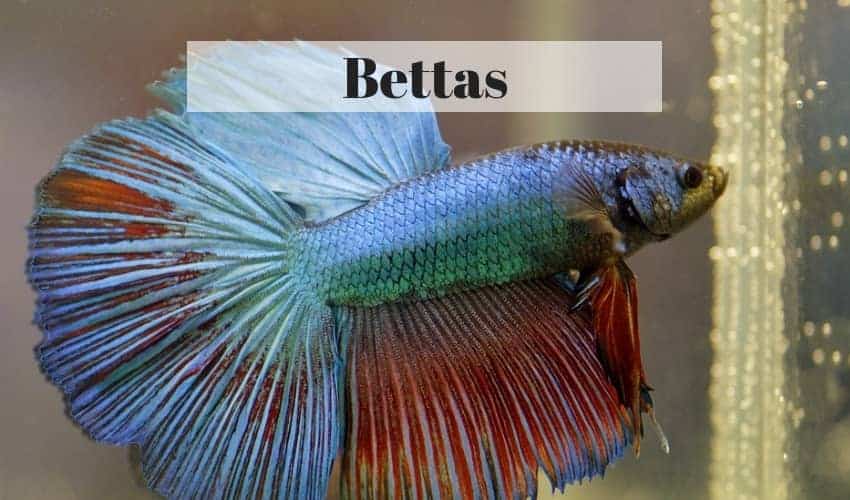
The Betta or Siamese fighting fish as it is more commonly known has to be one of, if not the best looking and most stunning fish that you could own. They come in a huge variety of colors, patterns, and tail types, and have a personality that is just bursting with pride and aggression.
Originally mainly found in the rice paddy fields of countries such as Thailand and Malaysia where they were drab and dreary in color, the Betta has now been developed and bred to be one of the most splendid looking species around. They are hugely popular with many aquarists who tend to specialize in keeping this remarkable fish.
To some, it may seem odd that the Betta even makes it onto a list of freshwater fish that are suitable for beginners, but as long as you get this species basic requirements spot on they are indeed incredibly easy to care for. Bettas need an aquarium of at least 5 gallons, they need excellently maintained water parameters, and most importantly they need to be the only fish in their tank.
Personality wise the Betta is one big fish that can be highly aggressive to others of its kind and even different species. This is exactly the reason they need to be solitary. Bettas will attack, maim, and possibly even kill other fish that come into their environment. Please note, this is true of both the male and female, although the male is definitely the bigger aggressor. Breeding and keeping sorority (all female) aquariums are definitely not recommended for beginner aquarists.
Despite the Bettas specific needs, they are a species that I personally would highly recommend keeping. I have been doing so myself for several years and have found them not only highly attractive but also very intriguing. Bettas are incredibly intelligent, will learn tricks for reward, and enjoy the interaction.
Varieties of betta include veil tails, rose tails, delta tails, half moons, crown tails, feather tails, plakats, and many more. They come in an incredible amount of solid colors, bi-colors, multi-colors, and even koi patterns.
Barbs

Barbs are a lively family of fish that are hardy, colorful, and love to school. They are best kept in groups of five or more and require boisterous companions due to their high level of activity within the aquarium. There are a variety of species within this family that vary greatly in size, color, and requirements. With this in mind here are some of the more common and popular types.
The black ruby barb grows to a maximum of 2.5 inches and requires a minimum aquarium size of 20 gallons. They are a striking deep red color with black tinges and one of the more peaceful barb species.
The Denison barb more commonly known as the red line torpedo is one of the larger barbs at 6 inches. They are peaceful but incredibly fast swimmers who enjoy plenty of swimming space. A minimum aquarium size of 55 gallons is required for this silver colored specimen with black and red stripes down its central body.
In comparison to the Denison barb, the cherry barb is the baby of the family at just 1 – 2 inches in length. Don’t, however, be fooled into thinking that this is not a striking fish because it is small, as it really is! They are an intense red with a dark band running from their head to tail and look incredible when kept in a large school. Larger schools are imperative for this species who when kept alone can become reclusive. 25 gallon is required for this peaceful barb that has become extremely popular.
The tiger barb is probably the most recognizable of the barb family with its silver body, black vertical stripes, and orange tipped fins. They can grow up to around 3 inches in length, need a 20-gallon aquarium, and are not recommended as a community fish. This is due to the tiger barb being extremely nippy with anything that crosses its path.
The final barb on our list is the real daddy of the family that can reach up to 13 inches in length. They require a minimum aquarium size of 55 gallons and can hold their own with other species such as cichlids. However, this does not mean they are an aggressive fish, they are actually really quite peaceful. They are also incredibly attractive with their silver ‘tin foil’ appearance and black and red fins.
Final Thoughts-Best freshwater fish for a new aquarium
We could have chosen the Top 20 freshwater fish for a new fish tank as there are many species to choose from that are suitable for a new aquarium. We narrowed it down as not to overwhelm you and to help you make your first tropical fish purchase easier.
Everyone will have their own opinion on the best tropical fish to start with and this is usually based on memories of their first-ever addition to their tank. We have selected the fish above for a number of reasons, temperament, hardiness, behaviors, and price. These are the most common factors most people will consider when setting up a new aquarium. By the way, we have a wonderful guide to help you successfully Set up your first aquarium.
We also have a complete guide to tropical fish disease just in case you find your fish are unwell or acting strangely. Many new aquariums will eventually suffer from one disease or another over time and having the right information to hand can help you quickly solve the problem. Here’s our guide to Tropical fish diseases.
We hope you enjoy your new aquarium and maybe you’ll consider a saltwater fish tank one day? They are amazing but take a little more experience to own and run successfully.
Good luck and please comment below if you own any of these fish or found this article helpful.
Hopefully, you have avoided one of the 30 Most common fishkeeping mistakes beginners make.
Happy Fishkeeping Forever!
Resourses Used
https://www.acs.edu.au/courses/aquarium-management-636.aspx
https://animals.howstuffworks.com/pets/aquarium-fish-care.htm
https://www.acsedu.co.uk/Courses/Pet-Care/AQUARIUM-MANAGEMENT-BEN105-744.aspx
https://www.bbc.co.uk/news/science-environment-33716589

I have been working in the tropical fish industry for over 30 years now and I’m still learning. Everyday is a school day in this hobby. In my spare time I play golf very badly!


